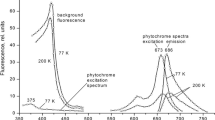Abstract
Etiolated seedlings of tobacco (Nicotiana tabacum L.) were exposed to single light pulses predicted to establish different proportions of phytochrome in its far-red absorbing form (Pfr/P). The angle between the cotyledons was compared in wild-type and transgenic seedling overexpressing Avena phytochrome A over the range of both very low-fluence responses (VLFR) and low-fluence responses (LFR). The unfolding of the cotyledons increased linearly for 24 h after the light pulse. At this time the Pfr/P-response curve showed two linear segments. The segment below a calculated Pfr/P = 3% (i.e. VLFR) was steeper than the segment above 3% (i.e. LFR). In the VLFR range the slope was almost threefold higher in transgenic than wild-type seedlings. However, in the LFR range the difference was less than 50%. From these data we propose that Avena phytochrome A makes a higher contribution to VLFR than LFR in etiolated tobacco seedlings.
Similar content being viewed by others
Abbreviations
- FR:
-
far-red light
- LFR:
-
low-fluence response
- Pfr/P:
-
proportion of phytochrome (P) in its FR-absorbing form (Pfr)
- R:
-
red light
- VLFR:
-
very low-fluence response
References
Abe, A., Yamamoto, K.T., Nagatani, A., Furuya, M. (1985) Characterization of green tissue-specific phytochrome isolated immunochemically from pea seedlings. Plant Cell Physiol. 26, 1387–1399
Ballaré, C.L., Sánchez, R.A., Scopel, A.L., Casal, J.J., Ghersa, C.M. (1987) Early detection of neighbour plants by phytochrome perception of spectral changes in reflected sunlight. Plant Cell Environ. 10, 551–557
Boylan, M.T., Quail, P.H. (1989) Oat phytochrome is biologically active in transgenic tomatoes. Plant Cell 1, 765–773
Brockmann, J., Schäfer, E. (1982) Analysis of Pfr destruction in Amaranthus caudatus L. Evidence for two pools of phytochrome. Photochem. Photobiol. 35, 555–558
Casal, J.J., Sánchez, R.A., Di Benedetto, A.H., De Miguel, L.C. (1991) Light promotion of seed germination in Datura ferox is mediated by a highly stable pool of phytochrome. Photochem. Photobiol. 53, 249–254
Cherry, J.R., Hershey, H.P., Vierstra, R.D. (1991) Characterization of tobacco expressing functional oat phytochrome. Domains responsible for the rapid degradation of Pfr are conserved between monocots and dicots. Plant Physiol. 96, 775–785
Cone, J.W., Jaspers, P.A.P.M., Kendrick, R.E. (1985) Biphasic fluence-response curves for light induced germination of Arabidopsis thaliana seeds. Plant Cell Environ. 8, 605–612
Downs, R.J., Hendricks, S.B., Borthwick, H.A. (1957) Photoreversible control of elongation of pinto beans and other plants under normal conditions of growth. Bot. Gaz. 118, 199–208
Drumm, H., Mohr, H. (1974) The dose-response curve in phytochrome-mediated anthocyanin synthesis in the mustard seedling. Photochem. Photobiol. 20, 151–157
Frankland, B. (1981) Germination in shade. In: Plants and the daylight spectrum, pp. 187–204, Smith, H., ed. Academic Press, London
Hecht, U., Mohr, H. (1990) Relationship between phytochrome photoconversion and response. Photochem. Photobiol. 51, 369–373
Kay, S.A., Keith, B., Deak, M, Furuya, M., Chua, N.-H. (1989) Rice phytochrome is biologically active in transgenic tobacco. Plant Cell 1, 775–782
Keller, J.M., Shaklin, J., Vierstra, R., Hershey, H.P. (1989) Expression of a functional monocotyledonous phytochrome in transgenic tobacco. EMBO J. 8, 1005–1012
Kelly, J.M., Lagarias, J.C. (1985) Photochemistry of the 14-kilodalton Avena phytochrome under constant illumination in vitro. Biochemistry 24, 6003–6010
Kronenberg, G.H.M., Kendrick, R.E. (1986) The physiology of action. In: Photomorphogenesis in plants, pp. 99–114, Kendrick, R.E., Kronenberg, G.H.M., eds. Marthinus Nijhoff Publishers, Amsterdam, The Netherlands
Mancinelli, A.L. (1986) Comparison of spectral properties of phytochrome from different preparations. Plant Physiol. 82, 956–961
Mandoli, D.F., Briggs, W.R. (1981) Phytochrome control of two low-irradiance responses in etiolated oat seedlings. Plant Physiol. 67, 733–739
Mohr, H (1972) Lectures on photomorphogenesis. Springer, Heidelberg, New York
Nagatani, A., Kay, S.A., Deak, M., Chua, N-H., Furuya, M. (1991) Rice type I phytochrome regulates hypocotyl elongation in transgenic tobacco seedlings. Proc. Natl. Acad. Sci. USA 88, 5207–5211
Sharrock, R.A., Quail, P.H. (1989) Novel phytochrome sequences in Araidopsis thaliana: structure, evolution, and differential expression of a plant regulatory photoreceptor family. Genes Devel. 3, 1745–1757
Shimazaki, Y, Pratt, L.H. (1985) Immunochemical detection with rabbit polyclonal and mouse monoclonal antibodies of different pools of phytochrome from etiolated and green Avena shoots. Planta 164, 333–344
Smith, H. (1982) Light quality, photoperception and plant strategy. Annu. Rev. Plant Physiol. 33, 481–518
Somers, D.E., Sharrock, R.A., Tepperman, J.M., Quail, P.H. (1991) The hy3 long hypocotyl mutant of Arabidopsis is deficient in phytochrome B. Plant Cell 3, 1263–1274
Thomas, B., Johnson, C.B. (1991) Phytochrome properties and biological action. Springer-Verlag, Berlin Heidelberg
Tokuhisa, J. G., Daniels, S.M., Quail, P.H. (1985) Phytochrome in green tissue: spectral and immunochemical evidence for two distinct molecular species of phytochrome in light-grown Avena sativa L. Planta 164, 321–332
Vierstra, R.D., Quail, P.H. (1986) The protein. In: Photomorphogenesis in plants, pp. 35–60, Kendrick, R.E., Kronenberg, G.H.M., eds. Marthinus Nijhoff Publishers, Amsterdam, The Netherlands
Vince-Prue, D. (1981) Daylight and photoperiodism. In: Plants and the daylight spectrum, pp. 223–242, Smith, H., ed. Academic Press, London
Wang, Y.-C., Stewart, S.J., Cordonnier, M.-M., Pratt, L.H. (1991) Avena sativa L. contains three phytochromes, only one of which is abundant in etiolated tissue. Planta 184, 96–104
Author information
Authors and Affiliations
Additional information
Financial support was provided by the University of Buenos Aires and Fundación Antorchas (Argentina) to J.J.C., CONICET (Argentina) to R.A.S. and the U.S. Department of Energy (DE-FG02-88ER13968) to R.D.V.
Rights and permissions
About this article
Cite this article
Casal, J.J., Sánchez, R.A. & Vierstra, R.D. Avena phytochrome a overexpressed in transgenic tobacco seedlings differentially affects red/far-red reversible and very-low-fluence responses (cotyledon unfolding) during de-etiolation. Planta 192, 306–309 (1994). https://doi.org/10.1007/BF00198564
Received:
Accepted:
Issue Date:
DOI: https://doi.org/10.1007/BF00198564




